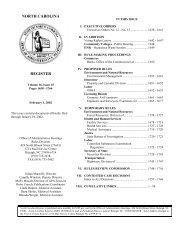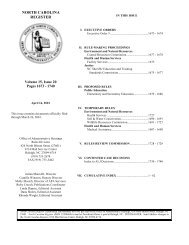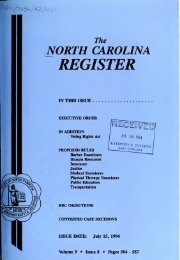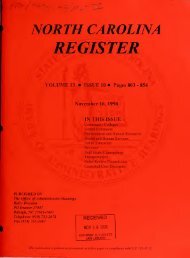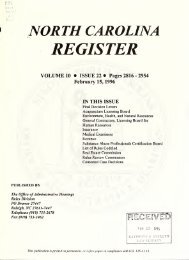NC Register Volume 24 Issue 19 - Office of Administrative Hearings
NC Register Volume 24 Issue 19 - Office of Administrative Hearings
NC Register Volume 24 Issue 19 - Office of Administrative Hearings
Create successful ePaper yourself
Turn your PDF publications into a flip-book with our unique Google optimized e-Paper software.
APPROVED RULES<br />
defined in Paragraph (f)(1) <strong>of</strong> this Rule may be<br />
developed for single-family residential<br />
purposes so long as the development complies<br />
with those standards to the maximum extent<br />
possible.<br />
(4) For an ORW nominated subsequent to June 1,<br />
<strong>19</strong>89, the effective date in Paragraph (f)(2) <strong>of</strong><br />
this Rule shall be the dates <strong>of</strong> nomination by<br />
the EMC.<br />
(g) Urban Waterfronts.<br />
(1) Description. Urban Waterfronts are waterfront<br />
areas, not adjacent to Outstanding Resource<br />
Waters, in the Coastal Shorelines category that<br />
lie within the corporate limits <strong>of</strong> any<br />
municipality duly chartered within the 20<br />
coastal counties <strong>of</strong> the state. In determining<br />
whether an area is an urban waterfront, the<br />
following criteria shall be met as <strong>of</strong> the<br />
effective date <strong>of</strong> this Rule:<br />
(A) The area lies wholly within the<br />
corporate limits <strong>of</strong> a municipality;<br />
(B)<br />
and<br />
the area has a central business district<br />
or similar commercial zoning<br />
classification where there is minimal<br />
undeveloped land, mixed land uses,<br />
and urban level services such as<br />
water, sewer, streets, solid waste<br />
management, roads, police and fire<br />
protection, or in an area with an<br />
industrial or similar zoning<br />
classification adjacent to a central<br />
business district.<br />
(2) Significance. Urban waterfronts are<br />
recognized as having cultural, historical and<br />
economic significance for many coastal<br />
municipalities. Maritime traditions and<br />
longstanding development patterns make these<br />
areas suitable for maintaining or promoting<br />
dense development along the shore. With<br />
proper planning and stormwater management,<br />
these areas may continue to preserve local<br />
historical and aesthetic values while enhancing<br />
the economy.<br />
(3) Management Objectives. To provide for the<br />
continued cultural, historical, aesthetic and<br />
economic benefits <strong>of</strong> urban waterfronts.<br />
Activities such as in-fill development, reuse<br />
and redevelopment facilitate efficient use <strong>of</strong><br />
already urbanized areas and reduce<br />
development pressure on surrounding areas, in<br />
an effort to minimize the adverse cumulative<br />
environmental effects on estuarine and ocean<br />
systems. While recognizing that opportunities<br />
to preserve buffers are limited in highly<br />
developed urban areas, they are encouraged<br />
where practical.<br />
(4) Use Standards:<br />
(A)<br />
The buffer requirement pursuant to<br />
Subparagraph (d)(10) <strong>of</strong> this Rule is<br />
not required for development within<br />
Urban Waterfronts that meets the<br />
following standards:<br />
(i) The development must be<br />
consistent with the locally<br />
adopted land use plan;<br />
(ii) Impervious surfaces shall<br />
not exceed 30 percent <strong>of</strong> the<br />
AEC area <strong>of</strong> the lot.<br />
Impervious surfaces may<br />
exceed 30 percent if the<br />
applicant can effectively<br />
demonstrate, through a<br />
stormwater management<br />
system design, that the<br />
protection provided by the<br />
design would be equal to or<br />
exceed the protection by the<br />
30 percent limitation. The<br />
stormwater management<br />
system shall be designed by<br />
an individual who meets any<br />
North Carolina occupational<br />
licensing requirements for<br />
the type <strong>of</strong> system proposed<br />
and approved during the<br />
permit application process.<br />
Redevelopment <strong>of</strong> areas<br />
exceeding the 30 percent<br />
impervious surface<br />
limitation may be permitted<br />
if impervious areas are not<br />
increased and the applicant<br />
designs the project to<br />
comply with the intent <strong>of</strong> the<br />
rule to the maximum extent<br />
feasible; and<br />
(iii)<br />
The development shall meet<br />
all state stormwater<br />
management requirements as<br />
required by the <strong>NC</strong><br />
Environmental Management<br />
Commission;<br />
(B) Non-water dependent uses over<br />
estuarine waters, public trust waters<br />
and coastal wetlands may be allowed<br />
only within Urban Waterfronts as set<br />
out below.<br />
(i) Existing structures over<br />
coastal wetlands, estuarine<br />
waters or public trust areas<br />
may be used for commercial<br />
non-water dependent<br />
purposes provided that the<br />
structure promotes, fosters,<br />
enhances or accommodates<br />
public benefit. Commercial,<br />
<strong>24</strong>:<strong>19</strong> NORTH CAROLINA REGISTER APRIL 1, 2010<br />
1716




